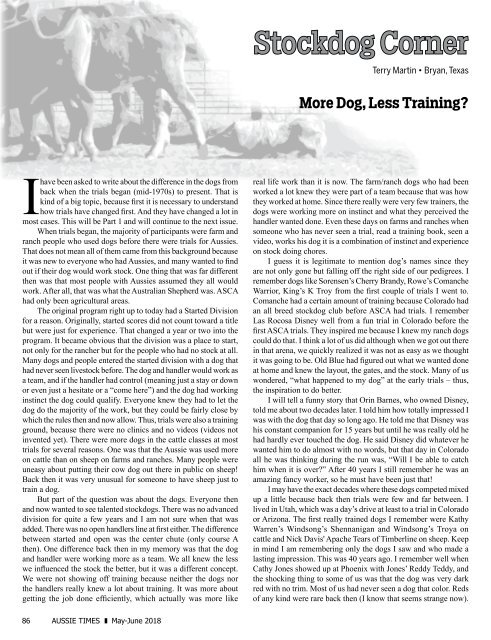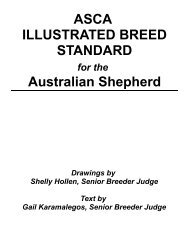2018 May June
You also want an ePaper? Increase the reach of your titles
YUMPU automatically turns print PDFs into web optimized ePapers that Google loves.
Stockdog Corner<br />
Terry Martin • Bryan, Texas<br />
More Dog, Less Training?<br />
I<br />
have been asked to write about the difference in the dogs from<br />
back when the trials began (mid-1970s) to present. That is<br />
kind of a big topic, because first it is necessary to understand<br />
how trials have changed first. And they have changed a lot in<br />
most cases. This will be Part 1 and will continue to the next issue.<br />
When trials began, the majority of participants were farm and<br />
ranch people who used dogs before there were trials for Aussies.<br />
That does not mean all of them came from this background because<br />
it was new to everyone who had Aussies, and many wanted to find<br />
out if their dog would work stock. One thing that was far different<br />
then was that most people with Aussies assumed they all would<br />
work. After all, that was what the Australian Shepherd was. ASCA<br />
had only been agricultural areas.<br />
The original program right up to today had a Started Division<br />
for a reason. Originally, started scores did not count toward a title<br />
but were just for experience. That changed a year or two into the<br />
program. It became obvious that the division was a place to start,<br />
not only for the rancher but for the people who had no stock at all.<br />
Many dogs and people entered the started division with a dog that<br />
had never seen livestock before. The dog and handler would work as<br />
a team, and if the handler had control (meaning just a stay or down<br />
or even just a hesitate or a “come here”) and the dog had working<br />
instinct the dog could qualify. Everyone knew they had to let the<br />
dog do the majority of the work, but they could be fairly close by<br />
which the rules then and now allow. Thus, trials were also a training<br />
ground, because there were no clinics and no videos (videos not<br />
invented yet). There were more dogs in the cattle classes at most<br />
trials for several reasons. One was that the Aussie was used more<br />
on cattle than on sheep on farms and ranches. Many people were<br />
uneasy about putting their cow dog out there in public on sheep!<br />
Back then it was very unusual for someone to have sheep just to<br />
train a dog.<br />
But part of the question was about the dogs. Everyone then<br />
and now wanted to see talented stockdogs. There was no advanced<br />
division for quite a few years and I am not sure when that was<br />
added. There was no open handlers line at first either. The difference<br />
between started and open was the center chute (only course A<br />
then). One difference back then in my memory was that the dog<br />
and handler were working more as a team. We all knew the less<br />
we influenced the stock the better, but it was a different concept.<br />
We were not showing off training because neither the dogs nor<br />
the handlers really knew a lot about training. It was more about<br />
getting the job done efficiently, which actually was more like<br />
real life work than it is now. The farm/ranch dogs who had been<br />
worked a lot knew they were part of a team because that was how<br />
they worked at home. Since there really were very few trainers, the<br />
dogs were working more on instinct and what they perceived the<br />
handler wanted done. Even these days on farms and ranches when<br />
someone who has never seen a trial, read a training book, seen a<br />
video, works his dog it is a combination of instinct and experience<br />
on stock doing chores.<br />
I guess it is legitimate to mention dog’s names since they<br />
are not only gone but falling off the right side of our pedigrees. I<br />
remember dogs like Sorensen’s Cherry Brandy, Rowe’s Comanche<br />
Warrior, King’s K Troy from the first couple of trials I went to.<br />
Comanche had a certain amount of training because Colorado had<br />
an all breed stockdog club before ASCA had trials. I remember<br />
Las Rocosa Disney well from a fun trial in Colorado before the<br />
first ASCA trials. They inspired me because I knew my ranch dogs<br />
could do that. I think a lot of us did although when we got out there<br />
in that arena, we quickly realized it was not as easy as we thought<br />
it was going to be. Old Blue had figured out what we wanted done<br />
at home and knew the layout, the gates, and the stock. Many of us<br />
wondered, “what happened to my dog” at the early trials – thus,<br />
the inspiration to do better.<br />
I will tell a funny story that Orin Barnes, who owned Disney,<br />
told me about two decades later. I told him how totally impressed I<br />
was with the dog that day so long ago. He told me that Disney was<br />
his constant companion for 15 years but until he was really old he<br />
had hardly ever touched the dog. He said Disney did whatever he<br />
wanted him to do almost with no words, but that day in Colorado<br />
all he was thinking during the run was, “Will I be able to catch<br />
him when it is over?” After 40 years I still remember he was an<br />
amazing fancy worker, so he must have been just that!<br />
I may have the exact decades where these dogs competed mixed<br />
up a little because back then trials were few and far between. I<br />
lived in Utah, which was a day’s drive at least to a trial in Colorado<br />
or Arizona. The first really trained dogs I remember were Kathy<br />
Warren’s Windsong’s Shennanigan and Windsong’s Troya on<br />
cattle and Nick Davis' Apache Tears of Timberline on sheep. Keep<br />
in mind I am remembering only the dogs I saw and who made a<br />
lasting impression. This was 40 years ago. I remember well when<br />
Cathy Jones showed up at Phoenix with Jones’ Reddy Teddy, and<br />
the shocking thing to some of us was that the dog was very dark<br />
red with no trim. Most of us had never seen a dog that color. Reds<br />
of any kind were rare back then (I know that seems strange now).<br />
86 AUSSIE TIMES <strong>May</strong>-<strong>June</strong> <strong>2018</strong>



